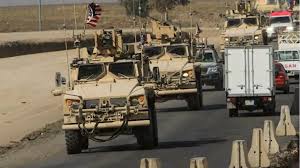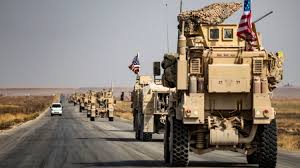Examiners question most recent Trump strategy move that apparently incorporates arrangement of more troops close by Kurdish powers.
The United States will station extra powers in eastern Syria to ensure oilfields in another arrangement move that one previous senior American authority called a “shocking ignorance” of history and topography.
The arranged fortification will occur in a joint effort with the Kurdish-drove Syrian Democratic Forces (SDF) to keep the oilfields from falling under the control of Islamic State of Iraq and the Levant (ISIL or ISIS), a Pentagon articulation said.
No subtleties were given on what number of or what sort of powers would be sent, or whether choices on those subtleties have been made.
“The US is committed to reinforcing our position, in coordination with our SDF partners, in northeast Syria with additional military assets to prevent those oilfields from falling back into the hands of ISIS or other destabilising actors,” it included.
Prior on Thursday, US President Donald Trump said via web-based networking media the US “will never let a reconstituted ISIS have those fields”.
The most recent declaration, be that as it may, negates Trump’s dubious choice prior this month to pull back powers from upper east Syria, which made ready for Turkey’s military activity in the territory.
In a meeting with Al Jazeera, Joshua Landis, a Middle East master at the University of Oklahoma, said the declaration was “emblematic of the chaos that has set in in the American foreign policy process”.
“It is in free-fall and the president is going back and forth,” Landis said. “This doesn’t really make much sense.”
The new sending could mean US powers would resemble “exposed targets” being positioned in a region, where the outskirts are watched by Russian and Syrian soldiers, they included.
“Who is going to safeguard them? The Kurds will have nothing to do with America. They have now made a deal with the Assad government. The whole thing makes no sense.”
Marwan Kabalan from the Arab Center for Research advised Al Jazeera the most recent move to re-convey powers to Syria mirrors the logical inconsistencies in US international strategy.
“US policy on Syria has been so inconsistent, it’s very difficult to predict whether the United States will stay or leave,” Kabalan said.
“The conflict is in Washington between President Trump and the foreign policy establishment, particularly the Pentagon. His eyes have always been on the upcoming election, he wants to boost support from his political base.”

‘Stunning obliviousness’
Brett McGurk, the top US authority driving Trump’s enemy of ISIL crusade until January, additionally condemned the most recent move in a web-based social networking post.
“The president of the United States of America appears to be calling for a mass migration of Kurds to the desert where they can resettle atop a tiny oilfield. Shocking ignorance of history, geography, law, American values, human decency, and honour.”
Trump had supported his prior choice to pull back US powers from Syria, saying he looked to achieve 1,000 soldiers home and end American association there.
Trump said already a “small number” of US troops would stay in Syria to verify the oilfields. An American authority told the Washington Post not long ago a proposition calls for 200 US troops to stay in the region.
News reports from Newsweek and US supporter Fox said another organization may incorporate many tanks and several officers.
The Turkish ambush on northeastern Syria and the US-united Kurdish powers has been stopped after the US handled a truce.
Ankara additionally facilitated an arrangement with Russia that saw the departure of Kurdish powers from a huge territory along Syria’s fringe with Turkey.
What about the oil?
The Kurdish powers held onto control of little oil fields in northeastern Hassakeh territory after Syrian government troops hauled out of a large portion of the Kurdish-greater part districts in 2012 to battle revolts somewhere else.
Subsequent to removing ISIL from southeastern Syria in 2018, the Kurds held onto control of the more gainful oil fields in Deir Az Zor area.
A calm course of action has existed between the Kurds and the Syrian government, whereby Damascus purchases the surplus through mediators in a gainful sneaking activity that has proceeded in spite of political contrasts. The Kurdish-drove organization offers raw petroleum to private purifiers, who utilize crude natively constructed treatment facilities to process fuel and diesel and sell it back to the organization.
The SDF presently sells Syria’s oil for about $30 per barrel.
The oil was relied upon to be a negotiating concession for the Kurds to arrange an arrangement with the Syrian government, which ineffectively attempted to arrive at the oil fields to retake them from ISIL. With Trump saying he intends to keep powers to verify the oil, it appears the oil will keep on being utilized for influence – with Moscow and Damascus.
McGurk said on Monday: “Oil, like it or not, is owned by the Syrian state. Maybe there are new lawyers, but it was just illegal for an American company to go and seize and exploit these assets.”
Prior to the war, Syria created around 350,000 barrels for each day, sending out its greater part. A large portion of that oil originated from eastern Syria. Remote organizations, including Total, Shell, and Conoco, all left Syria after the war started over eight years prior.
US Senator Lindsey Graham said subsequent to meeting with Trump on Thursday that he encouraged their to remain occupied with Syria.
“If you can find a way to secure the oil fields from Iran and ISIS, that’s in our national security interest,” Graham said.
A series of articles in “Linlithgowshire Journal & Gazette” interviewing some of the oldest inhabitants of We…
Disclaimer: The views, suggestions, and opinions expressed here are the sole responsibility of the experts. No People Reportage journalist was involved in the writing and production of this article.





